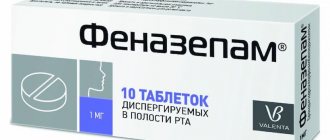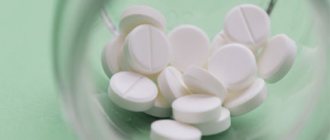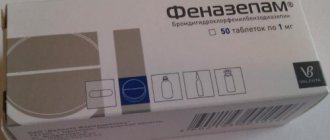Phenazepam is a tranquilizing drug with a sedative and hypnotic effect, which is prescribed for psychoneurological pathologies with fear and anxiety syndrome. A pharmacological drug often causes unpleasant consequences in the form of addiction and adverse reactions, so safer and no less effective analogues are selected instead.
Phenazepam: pharmacological features
Phenazepam is a potent tranquilizer based on the active substance bromodihydrochlorophenylbenzodiazepine. Phenazepam tablets are used in the treatment of various neuropsychiatric disorders accompanied by anxiety or fear syndrome.
Main indications for the use of a tranquilizer:
- alcohol withdrawal;
- alcohol, drug or drug intoxication of the body;
- neurosis;
- psychosis;
- phobias;
- epilepsy;
- hypochondriacal syndrome.
Phenazepam acts directly on the central nervous system, due to which it is widely used in neurosis-like, neurotic, psychopathic and psychopath-like conditions. Most often, such pathologies are accompanied by a feeling of panic, anxiety, increased irritability and emotional instability.
It is recommended to drink the pharmacological drug in a minimum dosage - no more than 0.25-0.5 tablets.
Phenazepam is sold in pharmacies only with a doctor's prescription. According to the law, this tranquilizer is included in the Register of Substances Subject to Special State Control. This resolution is enshrined in the Single Convention on Narcotic Drugs at the proposal of the UN.
Elokom is a hormonal ointment and cream for external use with a pronounced anti-inflammatory, regenerating and anti-allergenic effect. The drug is widely used in the field of dermatology and cosmetology for the treatment of allergic rashes and skin diseases. Read more in the article: “What is Elokom cream used for?”
Withdrawal syndrome after Phenazepam
Advertising:
Very often there is a need to select safer and no less effective substitutes for Phenazepam. This is due to the huge number of side effects that the tranquilizing drug causes.
One of the main disadvantages of the pharmacological drug is the dependence and persistent addiction that it causes with long-term use. It is extremely difficult to give up the medication, as withdrawal syndrome develops.
After taking Phenazepam, many patients experience prolonged depression, anxiety, increased anxiety and irritability, sensitivity to sound, light and tactile touch, convulsions of the upper and lower extremities. That is why, when taking a tranquilizer, you need to know how much Phenazepam you can drink so as not to get used to it.
The increased concentration of the active substance in the blood lasts up to 20-60 hours, after which Finazepam is excreted from the body in the urine.
When taking the drug Phenazepam, the dosage in tablets is 0.25-5 mg, which are divided into 2-3 doses. The exact dose of the tranquilizer is selected by the doctor individually, but it should not exceed 10 mg of Phenazepam per day. The maximum permissible duration of treatment is 8 weeks.
Coronavirus is a viral infection that infects humans through the mucous membranes of the nasopharynx and eyes. The microorganism spreads through the blood, binding to a certain type of protein, which causes damage to the respiratory tract and gastrointestinal tract, so it is important to quickly select drugs for treatment. Read more in the article: “what antibiotics are prescribed for coronavirus.”
Reviews
Irina K .: “At our house, my grandmother takes phenazepam. My son is 5 years old. I don’t know how we didn’t keep track of him, but he took 2 or 3 pills. We noticed when he became lethargic, reacted poorly to calls, and did not perceive others. The son spent more than a week in the intensive care unit. Now we store the drug on the upper mezzanines.”
Christina M .: “My son developed chorea after rheumatism. For hyperkinesis, the doctor prescribed diazepam, but it practically did not help. We were advised to change to phenazepam, but the doctor refused to prescribe this drug, explaining all the consequences. It’s good that they didn’t start an unauthorized reception. We hope that the disease will go away on its own by adulthood.”
Feedback from a pediatrician : “Phenazepam is one of those drugs that cannot be prescribed to patients under 18 years of age, regardless of their indications. I have seen several cases of children being poisoned with this substance. All of them were admitted in a severe comatose state. Fortunately, everyone survived. The consequences of taking the drug do not allow it to be given to people under the age of 18.”
Content
Cons of Phenazepam
Phenazepam is a powerful tranquilizer that causes various side effects. The most common ones include:
- attacks of nausea;
- vomit;
- Strong headache;
- painful abdominal cramps;
- bronchospasm;
- allergic skin rashes;
- apathy, drowsiness;
- destruction of the kidneys and liver;
- decreased blood pressure;
- deterioration of memory and brain activity.
Advertising:
When taking the tranquilizing drug Phenazepam, side effects in older people appear much more often and more intensely. That is why the drug is prohibited for use in old age.
In elderly patients, the tranquilizer causes serious impairment of motor coordination, which often causes dangerous injuries.
In some cases, instead of the expected sedative effect, Phenazepam has a stimulating effect on the nervous system, causing attacks of uncontrolled aggression and sudden mood swings.
In addition, with long-term use, Phenazepam inhibits the functioning of the cardiovascular system and disrupts full-fledged brain activity. For elderly patients, taking a tranquilizer can result in a stroke or myocardial infarction.
Compatibility of Phenazepam with alcohol
Many patients are interested in whether it is possible to take Phenazepam and alcohol at the same time - the consequences of such a combination can be life-threatening. The compatibility of a tranquilizer with alcohol is unacceptable, since ethyl alcohol significantly enhances the effect of the drug. This leads to severe intoxication of the body.
The action of the pharmacological agent is aimed at suppressing the increased excitability of the central nervous system, while at the same time alcohol has an stimulating effect. Taking a tranquilizing drug after drinking alcohol causes the so-called phenazepamine sleep - a dangerous condition in which the functioning of almost all internal organs and systems is inhibited.
In medical practice, there are cases where phenazepam sleep ended in cardiac arrest.
The simultaneous use of Phenazepam with alcoholic beverages increases the side effects of the pharmaceutical drug.
This combination causes severe vomiting mixed with blood, alcohol-induced confusion, attacks of uncontrollable aggression, disorientation in space, deterioration of thinking and the appearance of suicidal tendencies.
First aid
If a person takes Phenazepam with alcohol, then you need to immediately call an ambulance, because it is impossible to predict the consequences for the body and psychological state of a person. Before the doctor arrives:
- do a gastric lavage: give the person who consumed at least 6 glasses of water with soda, induce vomiting.
- give a sorbent: polysorb, smecta, polyphepan or activated carbon will do, this will prevent loss of consciousness;
- monitor the condition: do not leave the person alone; if he has lost consciousness, then lay him on his side and fix his tongue so that he does not swallow it during attacks of vomiting.
Compatibility of Phenazepam with other drugs
Phenazepam is one of the most potent tranquilizers that cannot be combined not only with alcoholic beverages, but also with many other medications. These include:
Advertising:
- sleeping pills;
- anticonvulsants;
- sedatives;
- tranquilizing.
Phenazepam and Corvalol, the compatibility of which is considered unacceptable, are strictly prohibited from being taken together. Corvalol contains ethyl alcohol and the tranquilising substance phenobarbital - which is why simultaneous use with Phenazepam causes an overdose of tranquilizers with the most severe consequences.
The drug should not be taken together with antiparkinsonian drugs, since Phenazepam significantly reduces their effectiveness.
When treating arterial hypertension, it must be taken into account that the tranquilizer increases the effect of antihypertensive medications. In such cases, it is necessary to reduce their dosage.
Also, Phenazepam tablets should not be combined with Clozapine and other antipsychotics. This drug combination often causes depression of breathing and the respiratory center.
How to recover from addiction?
If a person is addicted to drinking alcohol with Phenazepam, then only comprehensive treatment can help. And the sooner it begins, the fewer irreversible consequences a person’s physical and psychological health will receive. The risk that one day the addict will not calculate the dose and it will be too late to help will also disappear.
Do your loved ones need help treating alcohol addiction? Sign up for a free consultation by calling the AlkoZdrav help center hotline: 8-800-775-32-63 . Specialists will answer your questions, select an effective treatment plan and accompany you throughout the entire program.
We guarantee results if all our recommendations are followed.
The best analogues of Phenazepam
If the patient has contraindications to the use of Phenazepam or the tranquilizing drug causes side effects, it is best to consult a doctor to select a new, effective and safe drug.
| Medicine | Active substance | Manufacturer | average cost |
| Atarax | Hydroxyzine | UCB Pharma SA (Belgium) | 265-300 rubles |
| Tranquesipam | Bromodihydrochlorophenylbenzodiazepine | JSC Dalkhimfarm, Russia | 130-160 rubles |
| Fenzitate | Bromodihydrochlorophenylbenzodiazepine | JSC Tatkhimfarmpreparaty, Russia | 80-115 rubles |
| Phenibut | Aminophenylbutyric acid | JSC Organika, Russia | 60-160 rubles |
| Melaxen | Melatonin | Unipharm, Inc. (USA) | 520-560 rubles |
| Gidazepam | Hydrobenzodiazepine | JSC Interchem, Ukraine | 150-180 rubles |
Also common analogues of the tranquilizing drug include the drugs Amitriptyline, Adaptol, Gidazepam. Phenazepam analogues are produced by both Russian and foreign pharmacological companies. The difference between medications lies in the characteristics of the composition, indications and contraindications for use, possible side effects, as well as prescription or over-the-counter availability from the pharmacy chain.
Atarax and Phenazepam: similarities and differences
Advertising:
When prescribing tranquilizing drugs, many patients are interested in whether Atarax or Phenazepam is better. Answering this question, doctors emphasize that these drugs have different therapeutic effects, compositional features, and release forms.
Atarax and Phenazepam, the compatibility of which is considered prohibited (both are tranquilizers), are available in tablet form. Atarax is also produced in the form of a solution for intravenous or intramuscular injection. It also differs in its active substance, which is hydroxyzine hydrochloride.
The medication has a bronchodilator, decongestant, antiemetic and antihistamine effect on the body.
The drug Atarax is most often prescribed for the treatment of allergic reactions of various types, urticaria, eczema and skin rashes accompanied by itching, burning, redness and swelling. The drug is also used in the treatment of insomnia of various origins, menopause with psycho-emotional instability, neuroses, osteochondrosis, epilepsy, post-alcohol syndrome.
Only a doctor can decide which is better: Atarax or Phenazepam, since they differ not only in indications, but also in contraindications. The medicine should not be used for diseases of the urinary system, increased intraocular pressure, prostatic hyperplasia, persistent constipation, arrhythmia and dementia.
Tranquesipam - a substitute for Phenazepam
Tranquesipam is a complete structural analogue of Phenazepam with an identical composition, which belongs to the group of potent benzodiazepine tranquilizing drugs. Unlike its analogue, which is one of the first generation tranquilizers, Tranquesipam is a second generation drug.
Tranquesipam has a milder and more gentle effect on the central nervous system - it eliminates fear, panic, anxiety and emotional stress without worsening memory or slowing down brain activity. It does not inhibit the body’s cognitive functions—first-generation tranquilizers do not have such properties.
Tranquesipam and Phenazepam, the differences of which must be taken into account before taking them, are available in tablet form. The medication is prescribed for the treatment of various disorders - sudden mood swings, psychopathic and neurotic conditions, schizophrenia, substance abuse and alcoholism, seizures, nervous tics, increased muscle tension.
Advertising:
Tranquesipam, like its structural analogue, when taken for a long time or exceeding the recommended dosage, causes persistent addiction and serious dependence. Therefore, treatment with such pharmacological drugs should only be carried out under strict medical supervision.
Fenzitate and Phenazepam - the difference between the drugs
Phenzitate is a structural analogue of Phenazepam with an identical composition and main active ingredient. Both drugs belong to the group of tranquilizers that have tranquilizing, hypnotic, sedative and anticonvulsant effects.
Fenzitate and Phenazepam - these medications differ in the auxiliary components included in their composition (this must be taken into account by patients with a tendency to allergic reactions).
Pharmacological agents have the same indications for use - they are prescribed for the treatment of various forms of psychosis, depression, neuroses, and sleep disorders. Tranquilizing drugs are considered interchangeable and can be prescribed for the same diseases.
The main differences between the medications Fenzitate and Phenazepam are different manufacturers, as well as auxiliary components in the composition. If the first drug contains starch, gelatin, lactose and calcium stearate, then the second one contains talc, povidone, calcium stearate and lactose. Therefore, patients with lactose intolerance are prescribed Fenzitate.
Differences and features of the drug Phenibut
When answering the question about the drugs Phenazepam and Phenibut - what is the difference, you need to take into account that they both belong to psychotropic medications and are available in the form of tablets intended for oral administration.
The difference between pharmacological drugs lies in their composition. Phenazepam contains bromodihydrochlorophenylbenzodiazepine, Phenibut contains aminophenylbutyric acid hydrochloride.
Phenibut has a sedative, anticonvulsant and hypnotic effect. It not only affects the central nervous system, but also helps to relax muscles, eliminate tension, fear and anxiety.
Advertising:
Due to the peculiarities of its composition, Phenibut differs from Phenazepam in its indications for use. This medicine is prescribed for the treatment of epilepsy, neuroses, anxiety, psychopathy, insomnia, muscle hypertonicity, hyperkinesis and nervous tics, Meniere's disease and stuttering in children.
Phenibut and Phenazepam have a similar therapeutic effect, so they can be prescribed for anxiety, insomnia and depression. When choosing a medication, you need to take into account that Phenibut has a wider range of indications for use and is not addictive even with long-term use, but its analogue has a stronger effect.
Melaxen is a popular over-the-counter analogue
Melaxen is one of the popular and widespread over-the-counter analogues of Phenazepam. The drug is used to normalize sleep. The main differences of the drug are that it is often prescribed in the treatment of primary insomnia in elderly patients.
Melaxen tablets are prescribed for sleep disorders, frequent insomnia, regular daytime sleepiness, memory and attention impairment, incoordination and constant nightmares.
According to the pharmacological characteristics of the composition, Melaxen is a chemical analogue of the natural sleep hormone melatonin.
This means that it does not have an aggressive effect on the human central nervous system, acting more gently and sparingly than Phenazepam. Melaxen is available without a doctor's prescription, which indicates its safety for the human body. The drug can be used for self-treatment of sleep disorders. It does not disrupt its phases, helping to restore a good night's rest.
Description of Amitriptyline
Amitriptyline is an over-the-counter and safe drug that is most often used to treat depressive conditions of various origins. The medication is most effective in the treatment of anxiety and depression. Amitriptyline has a pronounced sedative effect and does not cause auditory or visual hallucinations. Main indications for the use of Amitriptyline:
- depression of various origins;
- psychoses;
- schizophrenia;
- increased anxiety and psychopathic pathologies in children;
- alcohol withdrawal;
- behavioral deviations;
- enuresis and bulimia of neurological origin.
Amitriptyline should not be used for glaucoma, serious diseases of the cardiovascular system, or during the recovery period after myocardial infarction.
Contraindications to taking the medication include drug, alcohol and drug intoxication of the body, children under 6 years of age, as well as hypersensitivity to the active components in the composition.
Pharmacological action of Gidazepam
Gidazepam is a drug from the group of benzodiazepine tranquilizers, which is considered an “easier” and safer substitute for Phenazepam. The drug is prescribed for the treatment of various sleep disorders, increased nervous excitability, anxiety, and emotional stress. Like its counterpart, it has anxiolytic and anticonvulsant effects.
Gidazepam differs from its analogue in its indications for use. The pharmacological drug is most often prescribed for various neurosis-like and neurotic conditions, logoneurosis, psychopathy, and migraine attacks.
Gidazepam is also often used to reduce fear, panic and emotional stress before surgery or a painful medical examination.
Like the substitute, Gidazepam causes a wide range of side effects, which include increased drowsiness, slower reactions and concentration, attacks of nausea and vomiting, decreased libido and allergic skin reactions.
In most cases, Gidazepam is used to treat mild and moderate forms of neurosis-like and neurotic disorders; in severe forms of the disease, Phenazepam is prescribed.
Safety and efficacy studies
In order for a drug to go on sale in pharmacy chains, it must go through several stages of many years of research. The first stage is testing on laboratory animals, then it is tested on healthy volunteers, and then on volunteers with a certain pathology. And only after that the medicine goes on sale.
There are groups of people for whom effectiveness and safety are determined separately. One such group is children. In order to authorize the use of a medicinal substance by persons under 18 years of age, it is necessary to conduct research on small animals, child volunteers, and sick children. For the last two studies, written parental permission is required.
If the drug showed questionable results at the previous stages of the study, it is not allowed to enter the subsequent stages. For some reason, phenazepam did not reach trials on child volunteers, so its status is defined as: “Effectiveness and safety when used in this group of patients has not been proven.” Sometimes funds receive this status because there are no volunteers.
If one of the stages of research on young patients has not been completed, regardless of the reason, the medicine is contraindicated for use by persons under 18 years of age.










